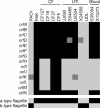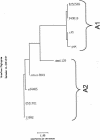Sequence polymorphism in the glycosylation island and flagellins of Pseudomonas aeruginosa
- PMID: 15028697
- PMCID: PMC374406
- DOI: 10.1128/JB.186.7.2115-2122.2004
Sequence polymorphism in the glycosylation island and flagellins of Pseudomonas aeruginosa
Abstract
A genomic island consisting of 14 open reading frames, orfA to orfN was previously identified in Pseudomonas aeruginosa strain PAK and shown to be essential for glycosylation of flagellin. DNA microarray hybridization analysis of a number of P. aeruginosa strains from diverse origins showed that this island is polymorphic. PCR and sequence analysis confirmed that many P. aeruginosa strains carry an abbreviated version of the island (short island) in which orfD, -E and -H are polymorphic and orfI, -J, -K, -L, and -M are absent. To ascertain whether there was a relationship between the inheritance of the short island and specific flagellin sequence variants, complete or partial nucleotide sequences of flagellin genes from 24 a-type P. aeruginosa strains were determined. Two distinct flagellin subtypes, designated A1 and A2, were apparent. Strains with the complete 14-gene island (long island) were almost exclusively of the A1 type, whereas strains carrying the short island were associated with both A1- and A2-type flagellins. These findings indicate that P. aeruginosa possesses a relatively low number of distinct flagellin types and probably has the capacity to further diversify this antigenic surface protein by glycosylation.
Figures





References
-
- Ansorg, R. 1978. Flagella specific H antigenic schema of Pseudomonas aeruginosa. Zentbl. Bakteriol. Parasitenkd. Infekkrankh. Hyb. Abt. 1. 224:228-238. - PubMed
-
- Bellingham, N. F., J. A. Morgan, J. R. Saunders, and C. Winstanley. 2001. Flagellin gene sequence variation in the genus Pseudomonas. Syst. Appl. Microbiol. 24:157-165. - PubMed
Publication types
MeSH terms
Substances
Associated data
- Actions
- Actions
- Actions
- Actions
- Actions
- Actions
- Actions
- Actions
- Actions
- Actions
- Actions
- Actions
- Actions
- Actions
- Actions
- Actions
- Actions
- Actions
- Actions
- Actions
- Actions
- Actions
- Actions
- Actions
- Actions
Grants and funding
LinkOut - more resources
Full Text Sources

